“This is monster opera!” – How Godzilla: King of the Monsters is honouring the legacy while breaking new ground
The director and cast of the kaiju sequel tell Total Film about the next giant step in the MonsterVerse
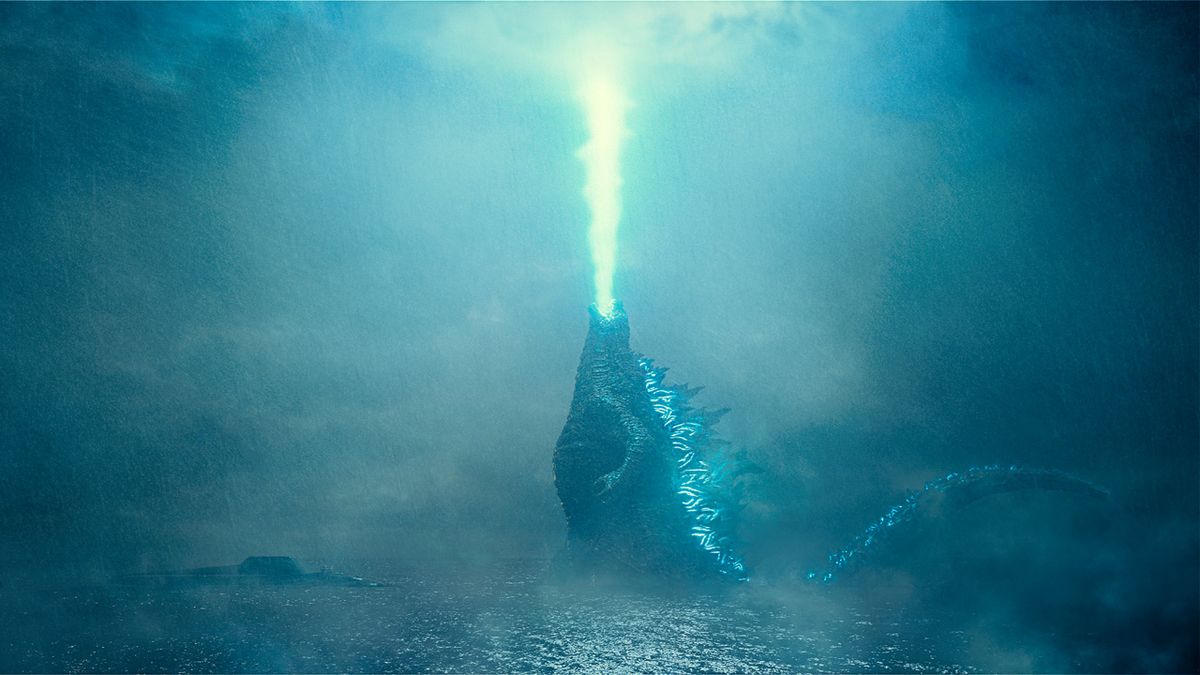
“’Exhausted’ is probably the best word to describe it.” Our sister publication Total Film magazine is catching up with director Michael Dougherty as he goes through the final quality-control stages on Godzilla: King of the Monsters. The picture is locked, but there are various international and home- entertainment versions that need signing off. It’s been a long road to this point, so ‘exhausted’ seems fair. “I feel like I’ve been fighting these monsters for three years!” Dougherty laughs.
Not that this fatigue has done anything to quell Dougherty’s irrepressible enthusiasm. A self-confessed Godzilla fanboy, this is a sacred gig for him, and by far the biggest directing job he has yet tackled: his earlier films include Krampus and ace horror anthology Trick ’R Treat, and he has blockbuster previous in scriptwriting X2 and Superman Returns. But Godzilla: King of the Monsters is an altogether different beast.
Indeed, it’s rare for a VFX-heavy blockbuster of this scale to be ready months ahead of its release date, but King of the Monsters isn’t just a sequel to 2014’s Godzilla, it’s a pivotal piece in a bigger shared ‘MonsterVerse’ that also includes Kong: Skull Island, and is building to a showdown between Godzilla and Kong in 2020. But let’s not get ahead of ourselves just yet. Godzilla has three equally iconic monsters to contend with before then.
Godzilla: King of the Monsters introduces a trio of new but familiar Titans to the mix: Rodan, a pteranodon-like winged firebird; King Ghidorah, a three-headed dragon-esque beast; and Mothra, a, well, moth-kaiju that you wouldn’t want to find fluttering outside your bathroom window at night.
“Obviously, Legendary and Warner Bros are building this MonsterVerse,” explains Dougherty. “And I’m a huge fan of that concept. When you think about it, Toho [the Japanese studio behind the original Godzilla franchise] started building these cinematic universes back in the 1960s and ’70s. Really, the ’50s, if you want to go back further.” As Dougherty goes on to point out, Rodan had a solo movie in 1956, two years after Godzilla’s debut. Mothra then had a standalone launch in 1961. Crossover ‘versus’ movies started to appear throughout the ’60s. G:KOTM continues that tradition by reintroducing a triptych of Godzilla’s most familiar stablemates.
Triple Threat
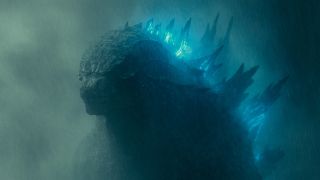
This new expanded universe for Godzilla and friends began in earnest with 2014’s Godzilla, directed by Gareth Edwards. A slow-burn monster movie with lofty ambitions, it saw Big G return to wreak havoc, with soldier Aaron Taylor-Johnson’s family caught in the collateral damage. Like Edwards’ breakout low-budgeter Monsters, it placed more emphasis on the humans than the creatures, and presented these prehistoric predators in a more grounded, real-world context.

For more in-depth features like the one you're reading right now, why not follow Total Film on GamesRadar for more exclusive and insightful breakdowns of the biggest films of the year.
In Edwards’ story, Monarch, a shady scientific research team, is monitoring the re-emergence of these old-world Titans. Godzilla returns as an unlikely saviour of humanity by taking out the two MUTOs (Massive Unidentified Terrestrial Organism); this ancient beast had been on Monarch’s watchlist since nuclear tests awoke him in the ’50s. The MonsterVerse then continued to take shake with 2017’s Kong: Skull Island, directed by Jordan Vogt-Roberts. A reimagining for the giant gorilla, it jumped back in time to 1973, with Vietnam War soldiers exploring Kong’s hitherto undiscovered home. It also proved that Monarch had been continuing to operate in the shadows since ’Zilla’s revival.
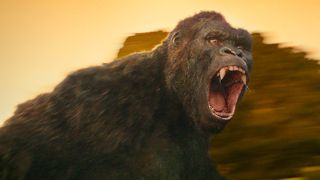
"Godzilla: King of the Monsters is both a direct sequel to Edwards’ film and also incorporates the broadening world that was hinted at in Skull Island"
So, Godzilla: King of the Monsters is both a direct sequel to Edwards’ film and also incorporates the broadening world that was hinted at in Skull Island. So where did that leave Dougherty – who also wrote the script with his frequent collaborator Zach Shields – when it came to positioning his take? “It was pretty much free rein, honestly,” he says of being approached by Legendary in March 2016. “The only thing that they asked for, which I was completely in agreement with, was to include Mothra, Rodan and King Ghidorah. And Monarch. But beyond that, it was a very loose development process.”
Sign up for the Total Film Newsletter
Bringing all the latest movie news, features, and reviews to your inbox
Taking on the film was – in Dougherty’s own words – “a very quick and very easy yes”. “I’ve been obsessed with the character since I was a toddler. And I’ve been drawing him... I mean, I recently found a Bible from grade school, and in there I found I’d drawn Godzilla into some of the illustrations. So he’d been with me for a very long time. Growing up, he was up there with Star Wars and superheroes and everything else. I mean, in some ways, above all that because he was a monster, and I always had some pity for monsters.”
As for what the existing MonsterVerse movies meant for Godzilla: King of the Monsters in terms of the style and tone – Godzilla being more sombre and slow-burn, Kong: Skull Island being bigger, broader, more bonkers – Dougherty calls it an evolution. “What I loved about Gareth’s approach was that it was very grounded and very real,” he says. “It felt like something you would see if you looked out your window. He kind of keeps the camera very grounded so that the creatures always felt very massive. And then Jordan pushed that further, and brought a lot of colour and vibrancy into his frames.”
Given that Godzilla has had a slow-burn origin, Dougherty says that “we definitely take the gloves off for this film”, so don’t expect the monster action to be stingily portioned out this time. After all, there are a lot of creatures to pack in. “I wanted to continue that evolution,” continues Dougherty. “You know, portraying the creatures as very realistic, but at the same time embracing the colour that they could bring – especially when you had a three-headed dragon that shoots lightning. You sort of have to embrace a more fantastical element when you bring in a giant moth, or a giant bird born out of a volcano. You try to keep it as grounded as you can, so that it feels real. But at the same time, you’re talking about very fantastical creatures.”
In the family
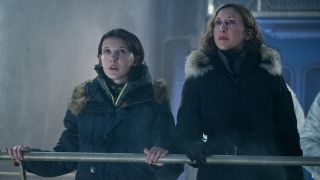
Godzilla: King of Monsters is set in a world that is now very much aware of the monster threat. Monarch had been able to keep a lid on the events on Skull Island, but the destruction in Hawaii, Las Vegas and San Francisco couldn’t be swept under the carpet. In fact, G:KOTM begins from the rubble of San Francisco in 2014, with the Russell family having suffered a huge loss amid the devastation. Comprising divorced parents Mark and Emma, and their teenage daughter Madison, the Russells are the throughline of the film in the same way the Brodys were in 2014.
As with the Brodys, they’re surrounded by an eclectic international supporting cast, including returnees Ken Watanabe and Sally Hawkins, and franchise newbies Charles Dance, Zhang Ziyi, O’Shea Jackson Jr., Thomas Middleditch and Bradley Whitford. But unlike the Brodys, the Russells don’t have an obvious action hero in their midst. Both Emma and Mark are scientists with skills that could prove very relevant to the emerging kaiju problem. Vera Farmiga (The Conjuring franchise) is Emma.
Describing her character, Farmiga tells TF, “I think first and foremost she’s a mother coping with grief and the absolutely devastating impact that the San Francisco attack had on her family. Her family was broken. It was shattered in the wake of that attack. And that’s where she’s operating from. The trauma of that attack has changed her acutely and profoundly.”
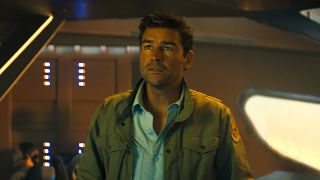
"Balancing the human drama on a film of this scale is no mean feat, which is why character actors were cast for Godzilla: King of the Monsters"
Emma’s also the inventor of the ‘Orca’, a machine capable of communicating with the Titans. Emma’s role at the heart of the story also puts a female spin on this particular Godzilla story. “What’s really cool for me [is] you have man’s most powerful weapons, and they’re rendered absolutely useless against the Titan invaders,” continues Farmiga. “Man has harnessed fire, but his military weapons, his superguns, the lasers... the deadliest are absolutely ineffectual against the kaijus. So what does it take? It takes the gentle strategy and nurturing touch of a woman. And I get to play that woman, which I thought was really cool... It’s a peaceful technology.”
Her ex-husband Mark is an animal-behaviour expert, played by Kyle Chandler, who’s as likeable and dependable in real life as he is on screen. Chandler actually has previous experience with King Kong – albeit one from a different cinematic universe – in Peter Jackson’s 2005 epic. “This was far more technical,” Chandler tells TF of the two VFX-heavy experiences. “There was more computer science going on, and more very fine-tuned adjustments. I remember doing a lot of takes on most of the scenes, because they had to have everything just perfect. But yeah, [King Kong] did prepare me. I learned a lot from working in New Zealand on the King Kong stuff. I knew a little bit about what I was getting into.”
The final part of the Russell trinity is their daughter Madison. The role marks the big-screen debut of Millie Bobby Brown, who’s already a global star thanks to her role as Eleven in Netflix smash Stranger Things. “Well, there were many reasons,” considers Brown, when TF asks why she chose King of the Monsters as her first film role. “The legacy that Godzilla movies have – it was just an honour to be a part of it, and for them to ask me to be part of the legacy. Truly. The other reason was the director. He’s worked with animal rights, and he loves animals, and I love animals. That’s probably a very childish thing to say, but honestly, I was like, ‘Oh my goodness, we’re going to get along so well.’ And I was really excited about the cast that was already going to be a part of it, which was Kyle Chandler and Vera Farmiga. It was like: ‘Why wouldn’t I want to work with them?’”
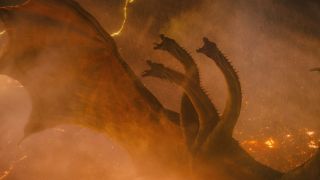
When some nefarious types become interested in Emma’s tech, Maddie also gets caught up in the global monster hunt. “The previous Godzilla really focused on the relationship of a father and a son,” says Farmiga. “At the heart of our film is this relationship between a mother and a daughter. It might be one of the first Godzillas that passes that Bechdel Test, from that perspective. Those were important things for me.”
To hear the three Russells speak, it sounds like they didn’t have any trouble finding that family dynamic on set. “Sometimes, you know, the work was a little bit harder than others, but I don’t think there was any time when we didn’t find the best in it,” considers Chandler. “We enjoyed ourselves and, you know, would take the piss out of each other, and have a great time.”

Looking for another film to get excited about? Why not check out our list of the most anticipated upcoming movies of 2019 and beyond
For Brown, the unjumbled chronology of the shooting schedule was a stark contrast to her TV work, as was working with the extensive VFX, although the team eased her into it. “They gave us some pre-vis – it’s kind of like a cartoon of the whole movie. So before the scene, when we did the rehearsal, they would basically show a version of the movie.” It made for a surprising experience seeing the finished footage. “Looking at a tennis ball [on set] and then looking at the real Godzilla, it’s just like, ‘Wow.’”
Balancing the human drama on a film of this scale is no mean feat, which is why Dougherty cast character actors. “The tricky thing with intertwining a human story with a Godzilla movie is that you don’t have as much real estate with the human story,” says Dougherty. “At least a third of your film, if not more, needs to be devoted to giant creatures beating the shit out of each other!” He erupts into a laugh. “So instantly you have less real estate to get into the depths of human despair and drama. So casting these iconic actors was a huge part of that, because they’re instantly likeable, in a sense. You almost instantly have an impression of who they are.” Because, let’s not forget, they’re not the only new trio of above-the-title stars here…
Fantastic Beasts
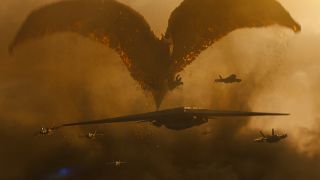
When it came to redesigning Ghidorah, Rodan and Mothra for the MonsterVerse, Dougherty headed straight back to the source. “I started with the Toho movies to just get a sense of their shapes, their silhouettes, their sounds,” explains Dougherty. “Growing up with them, obviously I had an idea in my head, but I really wanted to refresh myself with them, especially because they’ve evolved so much over the decades.”
The process became all about finding those key characteristics to refine and reshape, while being faithful to the spirit of the original monsters. “I wanted to make sure we stayed true to the core traits that really make us fall in love with the creatures,” he continues. “So Mothra for example, is very colourful. Ghidorah, again, he’s a three-headed dragon, but he has very distinct traits – the golden scales, the very particular bat-like wings, the cackle that he emits when he roars. It’s trying to retain those key elements, distil them, and update them.”
Dougherty is an animal lover, so it’s not surprising he looked to the natural world for inspiration for the creatures. “I wanted to bring in certain animal behaviours,” he says. “They have certain intimidation displays that they go about when they see a rival. What I love about that is, you sense a consciousness. I wanted to bring that to the creatures. I didn’t want to portray them as just big, dumb monsters – but rather, creatures who were thousands, if not potentially millions of years old, who have their own memories and even grudges.”
Picking up the MonsterVerse baton and running with it, Dougherty had a very clear idea of where he wanted to take the franchise. “Myself and my writing partner, Zach Shields, we kept saying that we wanted to put the ‘god’ back in Godzilla,” explains Dougherty. “By that, I mean the way that I always saw the creatures growing up. I didn’t see men in rubber suits. I saw ancient, powerful, mythic creatures. To me, these creatures were intelligent beings fighting out old grudges. They were the equivalent of dragons and giants, and all the creatures you read about in mythology and the Bible. That’s what they were. That’s sort of the element that we wanted to add to the film.”
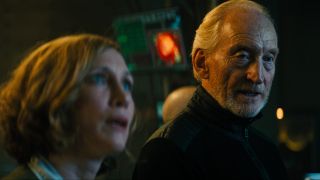
"Because Godzilla has 65 years of film history to draw on, Michael Dougherty describes the franchise as akin to a giant mural"
That mythic, epic quality extended to the soundtrack. The first trailer for Godzilla: King of the Monsters defied expectations when it was soundtracked by the gentle classical piano track ‘Claire De Lune’, by Claude Debussy. Dougherty also wanted a “counterintuitive” score for the film itself, and drafted in composer Bear McCreary, whose work on the Battlestar Galactica revival subverted space opera expectations.
“The soundscape I wanted to bring to this film was bringing in music that sounded like what might have existed when these creatures ruled the Earth,” says Dougherty. “Just something ancient and mysterious and powerful, and not just your typical modern-day tentpole movie score. So we brought in Taiko drummers from Japan. We brought in Japanese priests to chant. Even the lyrics in some of the chanting have significance.” It’s all in service of a heightened atmosphere. “There’s a certain operatic feel,” Dougherty adds. “I like to say that if Star Wars is space opera, then what we’re creating is ‘monster opera’.”
If you need any further evidence that Dougherty’s Godzilla fanaticism borders on the religious, you simply need to hear Dougherty talk about his trip to Toho Studios in Japan. “That was like a trip to Mecca,” he beams. “That was genuinely a spiritual experience for me, because not only did I get to wear a Godzilla suit, or at least a proportion of one, they took me to the soundstages where they shot the original films – including the ’54 film.”
Because Godzilla has 65 years of film history to draw on, Dougherty describes the franchise as akin to a giant mural. Of course, there’s that heritage to draw on and pay tribute to, but there’s also space to add something of your own. “Every artist who plays in the Godzilla universe gets to bring and add something new to it,” says Dougherty. “And besides the update in modern visual effects, I just wanted to bring a more mythic approach to these creatures.”
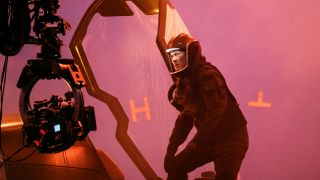
One specific invention for King of the Monsters is Godzilla’s lair, which we’ll finally get to see on screen. “I’ve always wondered, since I was a kid, where does Godzilla wander off to when the credits roll?” ponders Dougherty. “Because every Godzilla film ends with him wandering off into the ocean. Batman’s got a Batcave. Superman’s got the Fortress of Solitude. So it all seemed to make sense that Godzilla would have somewhere to go. Every creature tends to build some sort of a den or have some sort of a territory that they regularly inhabit. I love the idea that he returns to a place that, in some ways, was built for him by some previous human civilisation that established a symbiotic relationship with him.”
Again, it’s another aspect of the mythic, almost biblical treatment the monsters are getting this time out.
Let Them Fight
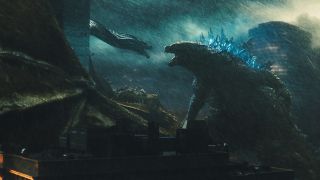
Like any shared-universe movie worth its salt, expect to leave Godzilla: King of the Monsters having consumed a number of breadcrumbs, teases and hints at a bigger world. “There are so many!” laughs Dougherty. “Layers upon layers of Easter eggs for the fans. We were adding some all the way into deep post-production. Even in the credits sequence at the end.”
Whatever the outcome in Godzilla: King of the Monsters, the big guy will return for another showdown in 2020’s Godzilla Vs. Kong, which will be the culmination of the MonsterVerse to date.
Adam Wingard (The Guest, Death Note) is directing Godzilla vs. Kong, but some characters will cross over to the sequel. “Adam came to visit the set for a day, which was great. I could just show him the literal figurative monster that he was about to inherit,” says Dougherty.
Chandler will also appear in Godzilla Vs. Kong, and sees Dougherty and Wingard as directors with very opposing styles. “For me, both of them were completely different,” he drawls. “A lot of directors, they have their different ways and different bedside manners. So yeah, I’d say they’re very different.”
Brown does see an obvious point of comparison though. “I think both of them are just monster fanboys,” she laughs. “They know every single detail of every single monster – every one that’s out there.”
While Godzilla Vs. Kong sees a new creative team take the reins, Dougherty and writing partner Shields have been able to have some input into the next film. “We did some rewrites on the script, just to help carry certain themes across, and to flesh out some of the characters,” explains Dougherty. “It was my first time writing for King Kong, so it was a thrill.” And with the bell soon to sound on that fight, who does this self-confessed fanboy have his money on in the clash between these two giants of cinema? “Who would win in a fight between Godzilla and Kong?” he grins. “The audience.”
Godzilla: King of the Monsters opens in the US and UK on May 31.
This feature originally appeared in our sister publication Total Film magazine, issue 283. Pick up a copy now or subscribe so you never miss an issue.
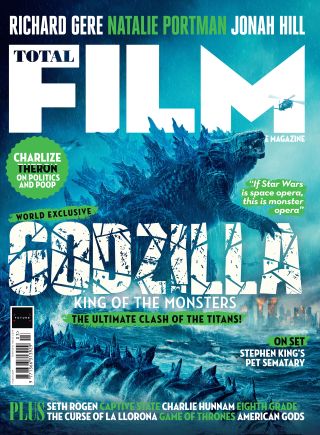

I'm the Editor at Total Film magazine, overseeing the running of the mag, and generally obsessing over all things Nolan, Kubrick and Pixar. Over the past decade I've worked in various roles for TF online and in print, including at 12DOVE, and you can often hear me nattering on the Inside Total Film podcast. Bucket-list-ticking career highlights have included reporting from the set of Tenet and Avengers: Infinity War, as well as covering Comic-Con, TIFF and the Sundance Film Festival.
Most Popular


